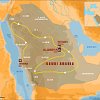The organizers of the Dakar Rally announced details last week about the route for the 2020 event, which will take place for the first time in Saudi Arabia. No doubt the country's massive flowing dunes and rugged mountains will provide great photo ops, but the natural features aren't the only forbidding landscape.

For one thing, while Spanish rider Laia Sanz is one of the top competitors in the motorcycle division, you can be sure there won't be any Saudi women competing in the Dakar this year, or any year in the visible future. Most Saudi women wouldn't even be able to go out and watch the Dakar competitors go by without being accompanied by an official male guardian.
You can also be sure the visiting media and rally participants won't be disturbed by any social unrest or unruly protests, as Saudi Arabia just went on a government killing spree, executing 37 men, some of them for acts related to anti-government protests.
Then there's the issue of Saudi Arabia's ban on nearly all visitors from the neighboring nation of Qatar. Three-time Dakar winner Nasser Al-Attiyah, in the car division, is Qatari. Amaury Sport Organization, organizer of the Dakar, said it has assurances that all competitors will be allowed to enter the country.
I could make some comment about strange bedfellows, but I wonder if that could get me arrested in Saudi Arabia.
Money is the root of all weirdness
The Dakar Rally is going to Saudi Arabia next year for one reason: money.
The rally was originally the Paris-Dakar Rally for the simple and appropriate reason that it began in Paris and ended in Dakar, Senegal, passing through northern Africa. It was a natural route for European adventurers to turn into a competitive rally. The European legs were mostly just a show. Real racing started in Africa.
Then in 2008 threats against the rally participants caused it to be canceled. So the entire affair was moved to South America. That was good in that South America offers every kind of dramatic and challenging terrain a rally could hope for. The bad was that it was far from Europe, where most teams originated.
Eventually, the rally route dwindled until this year when, for the first time, it took place entirely within one country: Peru. Time for another change, it seemed.
The old saying goes that race bikes don't run on gasoline. They run on money. That must be even more true for the cars and those monster off-road trucks. Saudi Arabia offered a lot of money to host the Dakar.
Now, about those women riders in Saudi Arabia. A year ago, there was a mini flurry of news coverage in the United States about how women were now allowed to drive a car or even ride a motorcycle in Saudi Arabia. I even heard from a few people who thought it was big news. Under the surface though, I don't think much changed. That coverage just showed photos of a few women on small motorcycles practicing in a private session, riding around some cones. Women presumably still can't ride if their official male guardians don't approve.
Despite (or maybe because of) those ongoing restrictions, the rally organizers made sure Sanz, as a high-profile female participant, was visibly on board with the change of venue.
Ganas de descubrir lo que nos espera! Seguro que será positivo para todos!! #Dakar2020
— Laia Sanz (@LaiaSanz_) April 25, 2019
I can't wait to see what's waiting for us! I'm sure it will be positive for everyone! @dakar
📰📽👉🏼 https://t.co/7Ly4JO89fl pic.twitter.com/hCZWOlT0bw
But really, the Dakar is going to be in Saudi Arabia for the same reason the MotoGP season starts in Qatar, and it's not because, as Sanz said in a video, that racers love to see new places. Nobody thinks that racing at Losail International Circuit is the ideal way to start the MotoGP season, at a track where there's a narrow and unpredictable window between the time the sun sets and invisible dew starts forming on the track, making it dangerous for racing. Nobody thinks racing in front of empty seats in the desert is better than racing in front of a hundred thousand excited fans in some other locations. And never mind Qatar's own dismal human rights record.
Racing takes cubic dollars, and the Middle East is where a lot of them are located, and that's why Dakar 2020 ends in al Qiddiya, an artificial city in the desert. At least they have some nice dunes, I hear.









